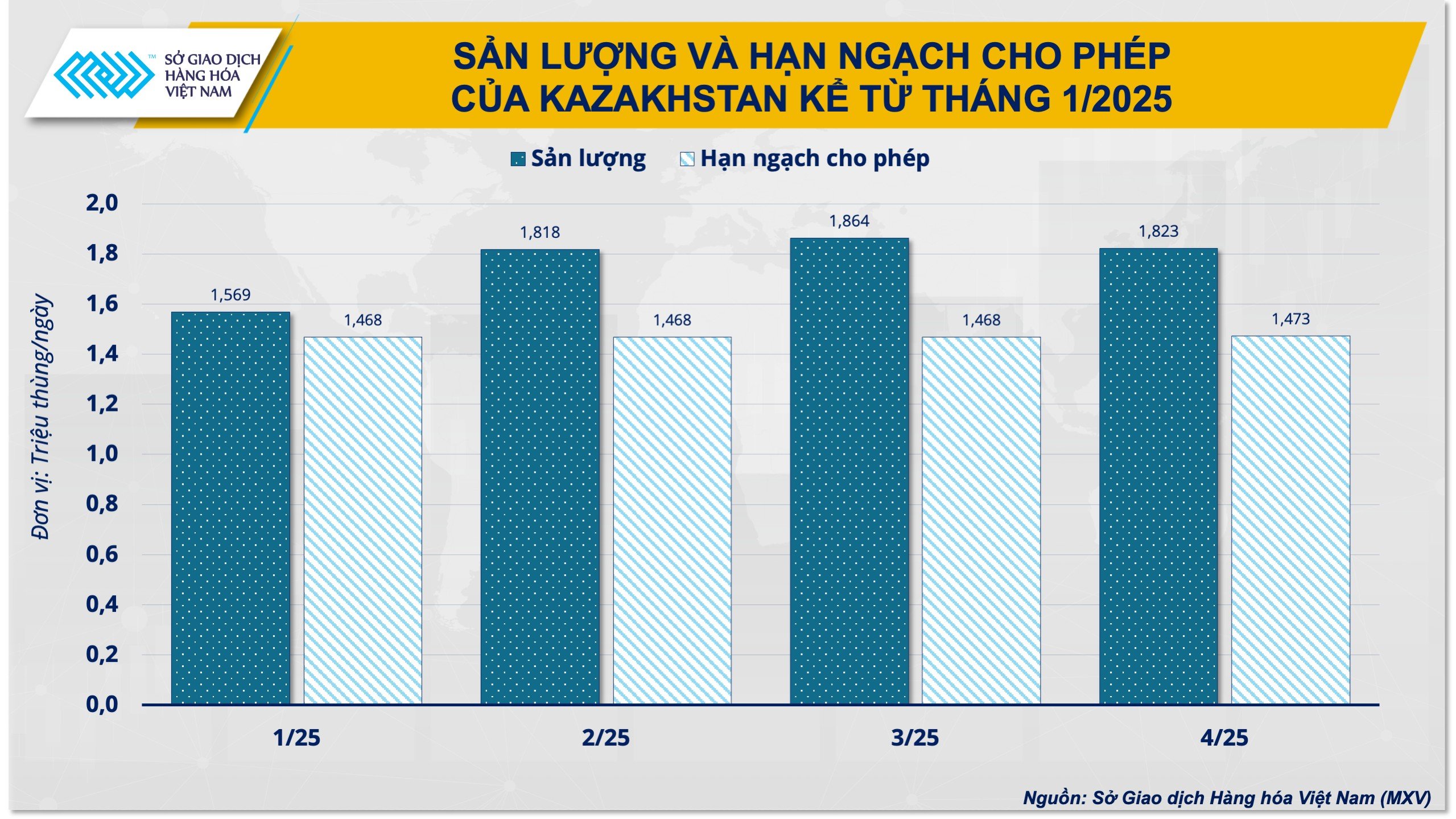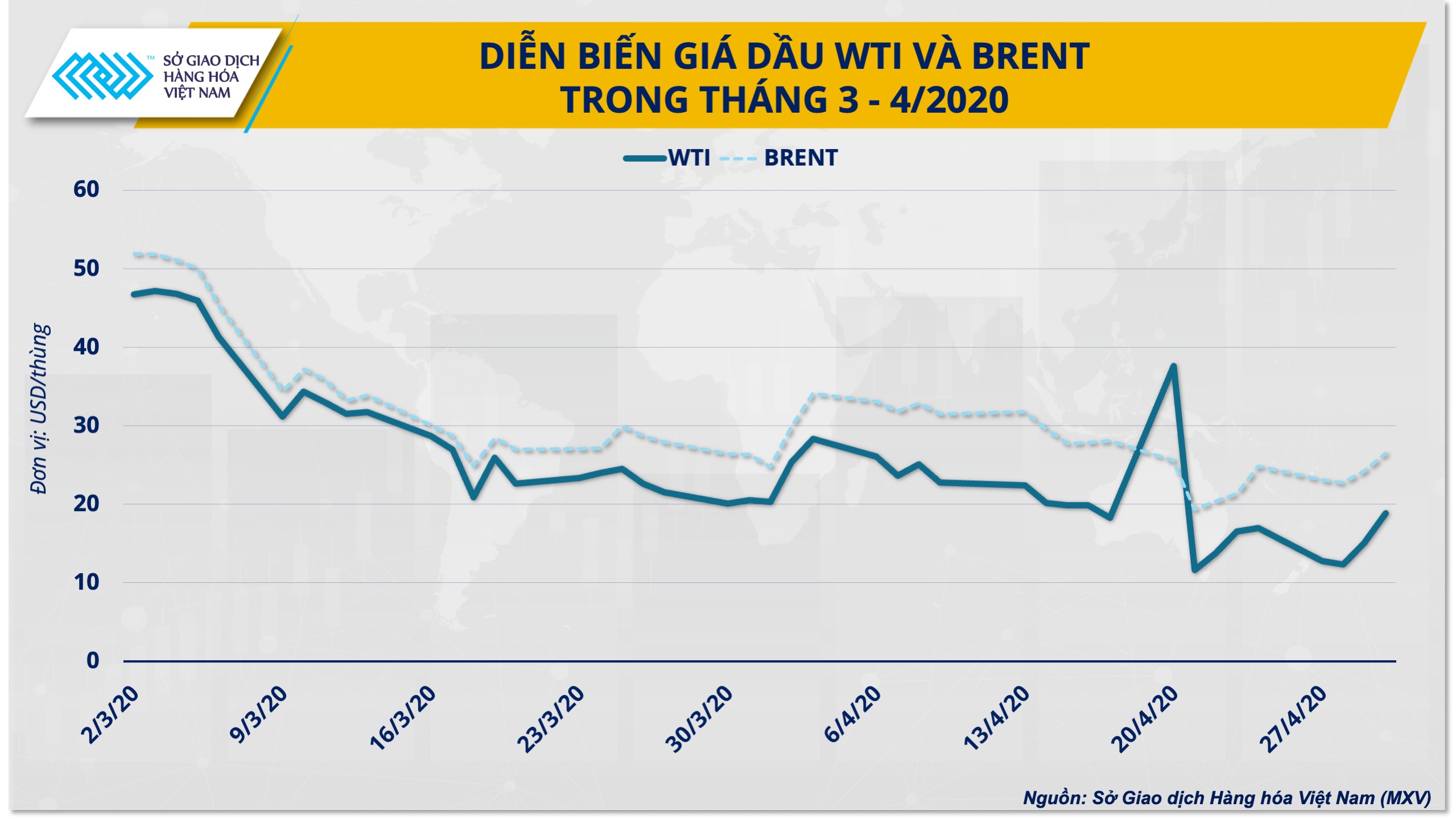While OPEC wants to maintain or increase its market share in global oil exports and production, it also wants to control supply to get good prices. Therefore, since 2016, OPEC has often used a policy of cutting production to push up oil prices. But now, in the context of continuously falling oil prices, why is this organization making a 180-degree turn by continuously increasing production?
Oil prices continue to fall
OPEC+ has been using production cuts to push up oil prices in recent times. However, due to many factors, oil prices have not only fallen but have also created momentum for a number of prolonged sell-offs in the market, making oil one of the worst performing major commodities since the beginning of the year.
According to data from the Vietnam Commodity Exchange (MXV), in May, the average trading price of WTI crude oil decreased by 19.5% and Brent oil price also lost more than 14% compared to the beginning of the year.
Previously, in April, Brent and WTI oil prices also fell 16% and 15% respectively, marking the month with the strongest "disastrous prices" since November 2021. Concerns about the risk of economic recession combined with OPEC+'s move to push more oil into the market were the main reasons for the oil price plunge.
According to analysts, the decision to increase production is driven by Saudi Arabia's strategy to tighten internal discipline and punish members who do not comply with OPEC+ cut quotas.
Founded in 1960, OPEC is based on the common interest of its members in limiting the world's oil supply to achieve higher prices. However, according to political scientist Jeff Colgan, OPEC is failing to achieve its stated goals. According to his research published in 2021 by Oxford University, OPEC members have cheated on 96% of their commitments, and a big reason for this is that member countries are not punished for not meeting their commitments.
And the situation continues to this day. Since the beginning of 2025, OPEC+ has twice asked countries to cut production beyond their quotas, and both times Kazakhstan was among the top two countries asked to cut the most. However, since February, Kazakhstan has continuously exceeded its quota by more than 350,000 barrels per day. Recent information released by Kazakhstan's Energy Minister Erlan Akkenzhenov does not show that the Central Asian country is taking its commitment to cut seriously.
Kazakhstan's production and quota chart as of January 2025 |
So will OPEC+ push oil prices down as a way to “punish” Kazakhstan? It is entirely possible. A typical example is the “oil price war” between Russia and Saudi Arabia in 2020. In just about a month, and with the impact of falling demand due to the economic recession, oil prices fell to negative levels. The economic damage is clearly predictable, but its impact on each economy will be relatively different. It can be seen that OPEC+, or specifically Saudi Arabia, is forcing Kazakhstan into a situation of “good harvest, low prices”.
Oil price chart in March-April 2020 |
Low oil prices in the future
It’s hard to judge which of the two main reasons had the greater impact on OPEC+’s decision, but there’s another factor to consider: the number of oil rigs in the U.S. According to a late-March survey by the Dallas Federal Reserve Bank of America on the WTI price at which companies are considering setting up new rigs, the average price given was $65 a barrel, a level the commodity hasn’t returned to since early April.
In early May, despite the global economic situation being more stable than a month earlier, WTI oil prices still fell below the $60/barrel threshold, with Brent also approaching this price range. And despite a subsequent price recovery, the possibility of a new price decline remains open, pending the latest OPEC+ decision on the production increase in July.
According to Mr. Duong Duc Quang - Deputy General Director of MXV, for oil prices to return to the threshold of 70 USD/month as in March, not only does it require an improvement in global trade relations, but OPEC+'s decision will also have to go against most market predictions of a third consecutive increase of 411,000 barrels/day. If either of the above two conditions does not occur, WTI oil prices will once again fall below the 60 USD/barrel mark, with Brent oil prices not far away, hovering around this price mark.
Van Ha - Hoang Phuc
Source: https://congthuong.vn/opec-gio-da-thich-gia-dau-thap-389870-389870.html





![[Photo] General Secretary To Lam receives Chief of the Central Office of the Lao People's Revolutionary Party](https://vphoto.vietnam.vn/thumb/1200x675/vietnam/resource/IMAGE/2025/5/30/140435f4b39d4599a3d17975dfb444c5)
![[Photo] National Conference "100 years of Vietnamese Revolutionary Press accompanying the glorious cause of the Party and the nation"](https://vphoto.vietnam.vn/thumb/1200x675/vietnam/resource/IMAGE/2025/5/30/1cf6cd5c8a934ebfa347028dcb08358c)

![[Photo] Journalists moved to tears at the Memorial Service for the soldiers who died in Gac Ma](https://vphoto.vietnam.vn/thumb/1200x675/vietnam/resource/IMAGE/2025/5/30/9454613a55c54c16bf8c0efa51883456)
![[Photo] A delegation of 100 journalists from the Vietnam Journalists Association visits the soldiers and people of Truong Sa island district.](https://vphoto.vietnam.vn/thumb/1200x675/vietnam/resource/IMAGE/2025/5/30/0984a986227d4e988177f560d2e1563e)

















































































Comment (0)